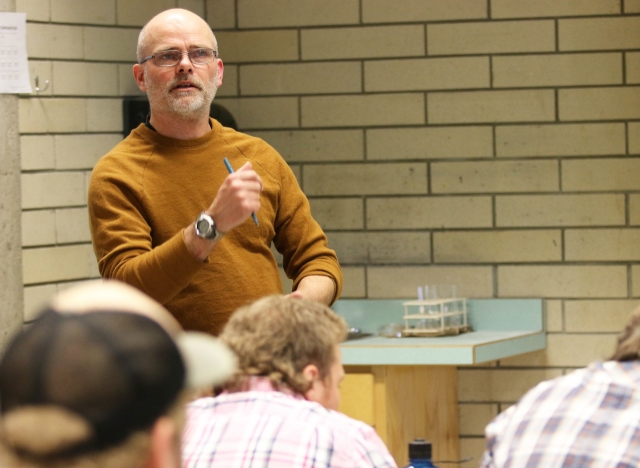Selkirk College School of Environment & Geomatics Students Share Research
Earlier this month, Selkirk College Castlegar Campus was abuzz with students from the Recreation Fish & Wildlife, Forestry, Integrated Environmental Planning, and Geographic Information Systems programs carrying posters and cue cards ready to share research with their classmates.
Second and third year students of the School of Environment & Geomatics presented their findings from applied research projects in a day-long student conference.
“It’s a great celebration of what they’ve done over the last nine months,” says School of Environment & Geomatics Chair Brendan Wilson. “Students have worked extremely hard and have answered some really interesting and important questions.”
There were 82 presenters filling classrooms and lecture theatres around the college on April 6 in the 14th year of the student conference. Talks ranged in topics from whether fracking coincided with earthquakes in Northern British Columbia, presented by Chelsea Mathieson to the effectiveness of partial cutting in the Harrop Proctor Community Forest presented by Dylan Tripp and Devin Dake-Outhet. Francis Morrell presented his site suitability analysis of cities in British Columbia in relation to snow and quality of life and Jeffery Ness spoke on the best solutions for small business when it comes to drones and remote data collection.
Students often chose their topics based on discovery during summer employment, lab work completed during school and personal interest. Then they went out and tackled a broader question. Presentations were as wide-ranging in topic as the students participating.
Integrated Environmental Planning student Avery Deboer-Smith has been working in water conservation with municipalities and regional districts for over a year. She presented findings from researching the water level, snow water equivalent and temperature changes in reservoirs of the Columbia Basin. Her talk was entitled “Blue Gold.”
“I wanted to find a way to get all this really convoluted data into a beautiful map that was really easy to understand for everyone in the community to inspire them to make changes in their lives to use less water,” she says. “It’s a valuable resource in our area and a lot of people may not realize last summer we had some serious issues with water shortages.”
Deboer-Smith has taken her passion for water conservation beyond the student conference and is helping host Water, Drought & Climate Change Forum in Nelson. At Selkirk College, she enjoyed the day with her fellow students and the experience of presenting.
“It’s about seeing people’s reactions to something like this,” she says. “The students seemed interested in learning more and joining me in being a part of this.”
Wilson says applied research plays a big role in answering community and workplace-based questions and to recognize how this factors into the education and the future careers of students is important.
“It’s an introduction for students, to help them get a sense of what it’s like to present applied research projects in front of a group of their peers,” he says. “It also gives them a sense of what it’s like to go to a scientific conference. There were a lot of concurrent sessions and a full day of really interesting talks. It’s a similar format to what they would experience out in the workplace or in their further academic careers.”
Selkirk College partner Applied Science Technologist & Technicians of British Columbia came on board for the conference offering up a generous prize to a student with the best presentation from each program.
“This is a great incentive and it highlights the level at which these students are actually providing information,” Wilson says.
The conference wrapped up with a keynote speaker. Dr. Rachel Holt from Nelson-based Veridian Ecological spoke to about her passion for the land, its biodiversity and her work in helping to create a better, scientific-based way to manage and preserve the critical habitat elements of the Great Bear Rainforest.






















